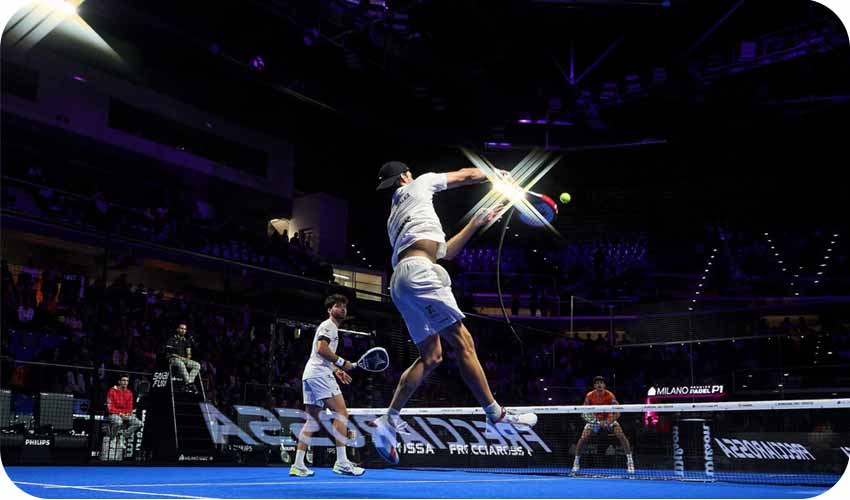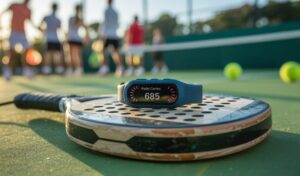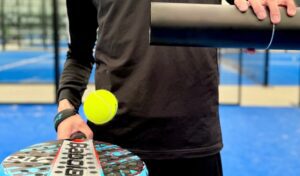The importance of Proper Padel lighting used in padel courts is a critical and frequently undervalued detail. Padel Tennis is one of the few racket sports played with an enclosed structure. Padel’s unique design requires dedicated lighting solutions to support the best possible player and audience experience – There must be evenness of sightline, safety and fairness.
High-quality Padel lighting is integral in taking the game to the next level. Padel Lighting must boost player’s performance, improve the spectator experience and complywith regulatory requirements. The article delves into the role of padel lighting, the ideal technical specifications, advantages of LED systems, and best practices for installation and maintenance, empowering players, facility managers, and enthusiasts to set up the perfect illuminated padel court to enhance the entire experience.
Why Does Padel Lighting Matter?
- Player Performance: Low lighting delays reaction times and muddles depth perception.
- Safety: Low or flickering lights raise the risk of tripping and collisions.
- Spectator Experience: Proper Padel lighting can provide improvement of the view for the audience.
- Regulatory Compliance: Many leagues require certain Padel lighting specifications (lux levels, etc.).

Information on the right equipment to illuminate your padel courts
Lux Levels
- Recreational courts: 200–300 lux.
- Competing courts: 500+ lux.
Uniformity Ratio
- Use a 0.7–0.8 uniformity ratio (min./max. light intensity) to eliminate “hotspots.”
Color Temperature
- 4,000–5,000K LEDs mimic daylight, reducing eye strain.
LED Lighting
Tournament-grade padel courts now exclusively use LED lighting. This industry standard delivers these unbeatable benefits:
- Energy Efficiency: 50–70% lower energy use vs. halogen.
- Longevity: 50,000+ hours lifespan.
- Adjustability: Control brightness and color temperature digitally.
- Eco-Friendliness: No harmful UV/IR emissions.

Designing a Padel lighting Layout
- Standard Courts: 20m x 10m.
- Mounting height: Install fixture 6 – 8 meters high to reduce glare.
- Angle Adjustments: Be sure to tilt fixtures at 25–30 degrees to prevent reflecting glass walls.
- Spacing: Place padel lights at the center evenly on all sides for uniform coverage.
Breaking Out of Bad Lighting Habits
- Glare: Use anti-glare shields and indirect Padel lighting techniques.
- Shadows: Ensure overlapping light beams cover the entire court.
- Flicker: Opt for high-quality LEDs with stable drivers.
The Energy Efficiency and Environmental Impact
LEDs reduce operating costs by 60% per year and their cooler output decreases air conditioning demand. Renewable systems like solar energy units are becoming popular in green facilities.
Make it Last: Maintenance Tips for Meaningful Lifespan
- Clean fixtures every 3–6 months to ensure dust doesn’t gather.
- Have an electrician inspect your wiring annually.
- Repair broken diffusers.
Conclusion
What you should know about the padel lights is that they are not just for visibility, they are to enhance the game. Taking the best efforts to understand and implement an LED Padel lighting approach (with precise layouts) and establishing regular maintenance (for players and facilities) can help create a safer, more enjoyable experience for all. Investing in quality Padel lighting provides dividends in performance and satisfaction.
Do you want to improve your Padel Game Plan? For additional insight of the sport and any Padel advice, keep your eyes peeled at PadelGamePlan.com!
FAQ – PADEL LIGHTING
Are existing halogen lights compatible with LED retrofitting?
Yes! The majority of LED kits are cross-fit with the old systems.
Do I need weatherproof lighting for outdoor courts?
Absolutely, lighting fixtures that are IP65/IP66 rated.
How do I measure light uniformity?
Use a lux meter and divide the lowest reading by the highest.
FAQ – PADEL IMPROVEMENT
How to get better at padel?
You will need regular practice, hit on the walls and watch matches of professionals. Read this Article – How to play Padel Tennis.
How can I improve my Service?
For more information on Padel Service, please read the Article – Best Padel Serve Techniques
Can I know more about the Rules of Padel Tennis?
Absolutely, for a beginner-friendly explanation of the Rules of Padel Tennis, please have a look at the Article – Rules of Padel Tennis. For Official Rules, please download the official rules of Internatlonal Padel Federation here.
FAQ – PADEL FOR CHILDREN
At what age should children start Padel Tennis for children?
Children as young as 4 can start out with foam balls and mini-rackets. The majority of clubs are for ages 5–15.
How does padel improve teamwork in kids?
Doubles requires constant communication and mutual strategies; collaboration is natural.
Can padel help academically?
Doubles requires constant communication and mutual strategies; collaboration is natural.
What is a good reason why padel is safer than tennis for little kids?
Enclosed courts, slower balls, and lighter gear reduce injury risks significantly.
Is there any competitive padel opportunity for kids?
Absolutely! Try to look for Junior leagues that offer Padel tournaments for under-12 and teen divisions. the positive impact of padel tennis on children
FAQ – PADEL EQUIPMENT
Do I need special padel tennis attire?
Please read the Article – Top Padel Clothing Essentials.
Do you have a checklist of padel tennis essentials I’ll need?
Could you recommend which padel balls I should use?
Please read the Article – Best Padel Balls.
Planning a Padel Tournament?
Use our Free Tool and get the schedule in seconds.
FAQ – PADEL TENNIS COURT
Is it possible to erect a padel court in my garden?
Installation is possible with a minimum area of 10m × 20m, subject to local zoning approval. For more information, Read this Article.
How much the cost of a padel court?
A typical padel court can range from AED 335,000 to AED 1,113,000, depending on materials, location and amenities. See the full cost breakdown here: Article – How much does it cost to build a padel court.
What about lighting required for the padel court – what advice can you give on that?
Please have a read through on the Article – Essential Padel Lighting Tips.






9 Responses